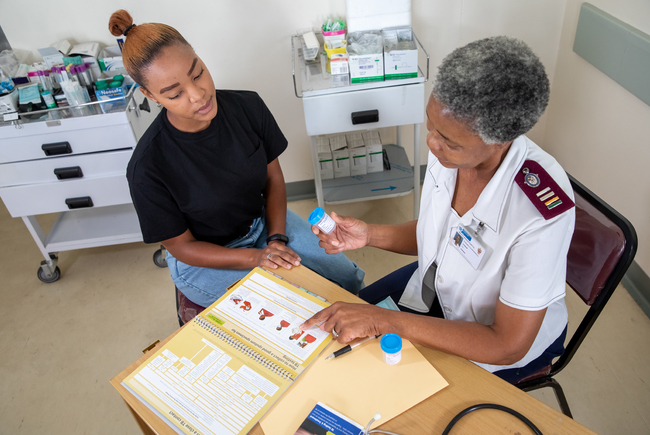Drugs not enough to stamp out parasitic worms in Africa
10 October 2018 | Story Justin Komguep Nono and Hlumani Ndlovu. Photo Alex Wynter, flickr. Read time 8 min.
Deworming has become a common practise across the world. It has proved very successful reducing the burden of parasitic worms among children by more than 50%.
The success of the last 17 years has been driven by deworming initiatives where school-going children get deworming tablets once to twice a year – and could have been greater if there was a vaccine.
But parasitic worms – found mainly in tropical and subtropical areas particularly in sub-Saharan Africa, the Americas, China and East Asia – remain a challenge. The World Health Organisation’s latest figures show that across the world, there are close to 1.5 billion people – about one-fifth of the world’s population – infected with parasitic worms.
The persistence of parasitic worms shows that deworming is not enough to interrupt the worms’ transmission. One part of the problem is that they live in the soil and water where they can constantly reinfect people even after they have been treated. Another part of the worm problem is that diagnoses are poorly efficient, anti-worm drugs are limited and tightly overlapping geographics and ecologics render co-infections with other diseases like HIV, malaria or tuberculosis frequent.
One part of the problem is that they live in the soil and water where they can constantly reinfect people even after they have been treated.
But most importantly, communities are not educated about the dangers. This means that even when they are treated they continue activities that result in them being reinfected.
The WHO has set a goal to eradicate the burden of parasitic worms in children by 2020. To do this, it’s advocating mass deworming campaigns. But the only way to achieve the 2020 goal is to combine deworming with other tools such as education campaigns.
We learnt some refreshing lessons in rural Cameroon on how this should be done. Our study looked at a campaign against schistosomiasis – more commonly known as snail fever. Part of the campaign involved educating children, teachers and legal guardians in rural Cameroon about the dangers.
The data we collected showed that mass drug administration alone had a questionable efficiency in halting schistosomiasis transmission. But that coupling mass drug administration of praziquantel to children with information about risk factors of infection might produce better outcomes. In fact, another recent study in Côte d’Ivoire unequivocally found that repeatedly informing communities how parasitic worms are transmitted and giving them a set of safe practices considerably helped to avoid reinfection.
This underscores the importance of including - among other complementary measures - extensive population awareness campaigns in the deworming strategies to reduce the burden of these diseases. Such health education ventures that are low-cost clearly constitute a necessary tool for creating the enabling environment for mass drug administration campaigns to thrive.
The challenges
There are four main challenges when it comes to managing parasitic worms. All are particularly visible in tropical and sub-tropical countries where sanitatory conditions are insufficient and people’s lifestyles undermine attempts to interrupt the transmission of parasitic worms.
Creating awareness in communities is critical and arguably the most cost-effective tool in an anti-worm strategy.
The first challenge is diagnosis. The diseases caused by parasitic worms are generally asymptomatic. This means that the early signs of infection are usually missed. In cases where people develop severe disease, they usually have symptoms like diarrhoea, abdominal pain, blood loss that can result in anaemia, cognitive deficit and tissue destruction. On rare occasions, these diseases can result in death.
But because people don’t show symptoms, most do not know that they have the worms in their body until the parasites proliferate.
The second problem is reinfection. Even after populations receive treatment, they can still be reinfected.
The third challenge is that there is a limited repertoire of anthelminthic drug therapies. These have been repeatedly administered for decades raising concerns about drug resistance in areas targeted for frequent campaigns.
And the fourth is the problem of co-infections with major communicable diseases such as HIV, malaria or tuberculosis. In many instances the parasitic infections accelerate the course of these diseases and worsen their burden.
Tackling the problem
Creating awareness in communities is critical and arguably the most cost-effective tool in an anti-worm strategy.
Educational campaigns should include three vital messages. The first must explain how parasitic worms are spread, the second must explain the importance of sanitation in preventing transmission and the third should stress the limitations of mass drug treatments.
It is important to educate and involve infected people in mass deworming campaigns. There are some examples of success. Kenya, for example, has managed to eradicate Guinea worm disease as a result of deworming campaigns being complemented by health education. Guinea worm disease is caused by Dracunculus medinensis – a long, thread-like worm.
Educational campaigns should include three vital messages. The first must explain how parasitic worms are spread, the second must explain the importance of sanitation in preventing transmission and the third should stress the limitations of mass drug treatments.
These campaigns should include messages on how to protect water sources and sanitation and hygiene practices.
Unless these health awareness campaigns are incorporated into strategies that target parasitic worms, there won’t be much improvement in trying to sustainably reduce the burden of parasitic worms and achieve the elimination rather than the control of these diseases.![]()
Justin Komguep Nono is a research officer at the Institute of Medical Research and Medicinal Plant Studies (Cameroon) and a research fellow at the University of Cape Town. Hlumani Ndlovu is a lecture at the University of Cape Town.
Research & innovation





































